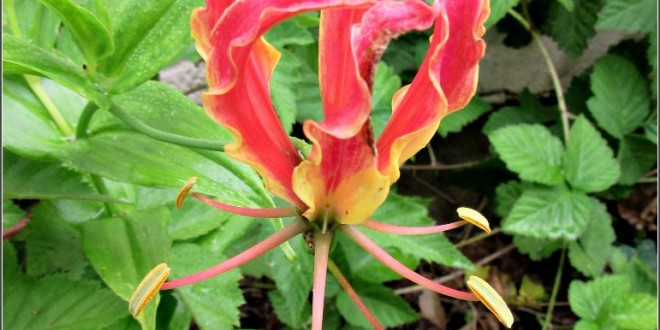The exotic yellow and red blossoms of the gloriosa lily (Gloriosa superba), also known as the glory lily, flame lily and climbing lily, cover the plant’s 3- to 8-foot-tall vine. Native to Africa and Asia, gloriosa lilies are generally available in two colors: the red “Rothschildiana” and yellow “Lutea.” A tender perennial, this tropical vine thrives in the warm summer temperatures of U.S. Department of Agriculture plant hardiness zones 8 through 10. Also grown as an annual or potted plant, with winter protection it can overwinter in the ground in mild climates.
Select a warm, sunny, well-drained location in the garden, where the lily will receive at least six hours of sunlight daily. If the soil is heavy clay or boggy, consider building a raised planter for the lily.
Rake 2 inches of well-decomposed compost over the garden bed. Dig the compost in with a shovel, mixing the soil thoroughly to a depth of 9 to 12 inches. Avoid using peat moss or other acidic supplements; gloriosa lilies prefer a neutral to alkaline soil with a pH of 5.8 to 6.5.
Dig a planting hole 2 to 4 inches deep with a trowel; if planting several lilies, place them 8 to 12 inches apart. Place the tuber horizontally in the hole, avoiding touching the ends. If the growing tip is damaged, it may delay the lily’s sprouting.
Cover the tuber with soil and tamp gently. Water the planting hole but avoid soaking until the ground is waterlogged as it will rot the tuber.
Place a wire or string trellis 3 inches behind the planting hole. The gloriosa lily is a climbing vine, but the tendrils are small and wind best around supports that are less than the diameter of a pencil.
Add a 4-inch layer of mulch over the garden bed, pulling it back 3 inches from the planting hole. Mulch slows water evaporation from the soil, which helps maintain a consistent moisture level. It also suppresses weeds.
Things You Will Need
Rake
Compost
Shovel
Trowel
Trellis
Mulch
Tips
Monitor the soil carefully and water when it is dry to a depth of 2 inches.
After the lily has sprouted, fertilize weekly with a slow-release or liquid 15-9-15 fertilizer.
Gloriosa lilies prefer high humidity; mist with water regularly.
Warnings
Every part of the gloriosa lily is poisonous; keep the tubers and plants out of reach of children and pets.
Remove the seeds from the plants to avoid accidental ingestion by children or pets.
Wash your hands thoroughly after handling the tuber, leaves, blossoms or seeds.








